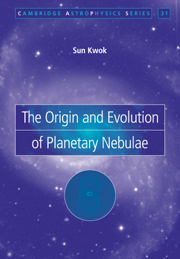Book contents
- Frontmatter
- Contents
- Preface
- 1 History and overview
- 2 Ionization structure of planetary nebulae
- 3 Nebular line radiation
- 4 Nebular continuum radiation
- 5 The neutral gas component
- 6 The dust component
- 7 Observations of the central star of planetary nebulae
- 8 Morphologies of planetary nebulae
- 9 Problems and questions
- 10 Asymptotic giant branch stars – progenitors of planetary nebulae
- 11 Evolution of the central stars
- 12 Formation of planetary nebulae
- 13 Dynamical evolution of planetary nebulae
- 14 Protoplanetary nebulae – the transition objects
- 15 Evolution to the white dwarf stage
- 16 Distances to planetary nebulae
- 17 Comparison between evolutionary models and observations
- 18 PN in the galactic context
- 19 Chemical abundances
- 20 Planetary nebulae in other galaxies
- 21 Concluding remarks
- References
- Appendix List of symbols and abbreviations
- Subject index
12 - Formation of planetary nebulae
Published online by Cambridge University Press: 04 November 2009
- Frontmatter
- Contents
- Preface
- 1 History and overview
- 2 Ionization structure of planetary nebulae
- 3 Nebular line radiation
- 4 Nebular continuum radiation
- 5 The neutral gas component
- 6 The dust component
- 7 Observations of the central star of planetary nebulae
- 8 Morphologies of planetary nebulae
- 9 Problems and questions
- 10 Asymptotic giant branch stars – progenitors of planetary nebulae
- 11 Evolution of the central stars
- 12 Formation of planetary nebulae
- 13 Dynamical evolution of planetary nebulae
- 14 Protoplanetary nebulae – the transition objects
- 15 Evolution to the white dwarf stage
- 16 Distances to planetary nebulae
- 17 Comparison between evolutionary models and observations
- 18 PN in the galactic context
- 19 Chemical abundances
- 20 Planetary nebulae in other galaxies
- 21 Concluding remarks
- References
- Appendix List of symbols and abbreviations
- Subject index
Summary
Traditional theories of PN ejection appeal to a variety of sudden ejection mechanisms including dynamical instabilities induced by recombination (Roxburgh, 1967; Lucy, 1967), pulsational instabilities (Kutter and Sparks, 1974; Wood, 1974; Tuchman et al., 1979), envelope relaxation oscillations due to thermal instability in the core (Smith and Rose, 1972), radiation pressure (Faulkner, 1970; Finzi and Wolf, 1971), or thermal pulses (Härm and Schwarzschild, 1975; Trimble and Sackman, 1978). The pulsation models represent an extension of the theory of Mira pulsation and predict that finite amplitude pulsation in the fundamental mode is not possible, leading to subsequent relaxation oscillations and PN ejection (Wood, 1981). The thermal-pulse theories rely on the luminosity peak just after the helium flash, which could lead to greater pulsational instability as the result of an enlarged stellar radius. Although these sudden-ejection models are intuitively appealing, none of them is quantitatively successful in ejecting the right amount of mass.
The difficulties of the sudden-ejection models should have been apparent given Paczyński's results. Paczyński's models have shown that the central star will remain at low effective temperatures if the envelope mass is higher than ∼10–3M⊙. It is impossible for any instability mechanism to be so precise in leaving behind just the right amount of mass. For example, if the sudden ejection removes 0.199 M⊙ instead of 0.2 M⊙, the star will stay on the red side of the H-R diagram long after the (never-ionized) nebula is completely dissipated.
- Type
- Chapter
- Information
- The Origin and Evolution of Planetary Nebulae , pp. 124 - 133Publisher: Cambridge University PressPrint publication year: 2000



